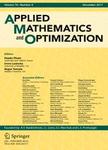版权所有:内蒙古大学图书馆 技术提供:维普资讯• 智图
内蒙古自治区呼和浩特市赛罕区大学西街235号 邮编: 010021

作者机构:Univ Notre Dame Notre Dame IN 46556 USA Univ Houston Houston TX USA Univ Zagreb Zagreb 41000 Croatia
出 版 物:《APPLIED MATHEMATICS AND OPTIMIZATION》 (应用数学和优化)
年 卷 期:2016年第73卷第3期
页 面:433-473页
核心收录:
学科分类:07[理学] 070104[理学-应用数学] 0701[理学-数学]
基 金:US National Science Foundation [DMS-1318763, DMS-1311709, DMS-1262385] Croatian Science Foundation (Hrvatska Zaklada za Znanost) UH Cullen Chair Funds Direct For Mathematical & Physical Scien Division Of Mathematical Sciences Funding Source: National Science Foundation
主 题:Fluid-structure interaction Nonlinear moving-boundary problem Existence of a solution Cardiovascular stents Kinematically coupled beta-scheme
摘 要:We study a nonlinear fluid-structure interaction problem between an incompressible, viscous fluid in 3D and an elastic structure whose Lame elastic parameters, thickness and density are all functions of space allowing jump discontinuities. This problem is motivated by studying the interaction between blood flow and arterial walls treated with vascular prostheses called stents. A stent is a metallic mesh-like tube used to prop the clogged arteries open. The Navier-Stokes equations for an incompressible, viscous fluid are used to model blood flow, and the cylindrical Koiter shell equations with discontinuous coefficients are used to model the elastic properties of arterial walls treated with stents. The fluid and structure are coupled via two coupling conditions evaluated at the moving fluid-structure interface. No assumption on axial symmetry is used in the model. We prove the existence of a weak solution to the underlying nonlinear 3D moving-boundary problem, and design a loosely-coupled partitioned scheme (beta-scheme) for its solution. The numerical scheme was motivated by the main steps in the constructive existence proof. The existence proof shows that the proposed numerical beta-scheme converges to a weak solution of the nonlinear problem. This is the first convergence result for the proposed partitioned beta-scheme. Several numerical examples are presented where different stent configurations are considered. The numerical fluid-structure interaction solutions clearly show that the presence of a stent induces wave reflections in arterial walls, and significant flow disturbances, especially near the proximal site of the stent.